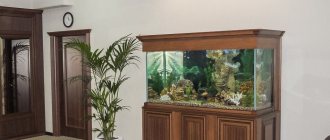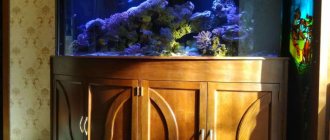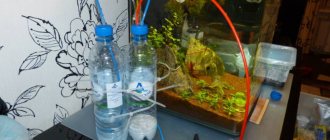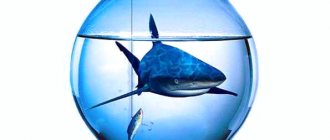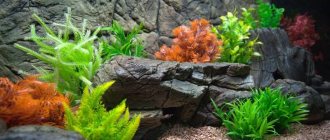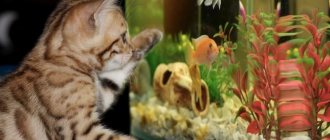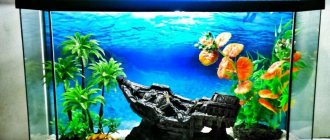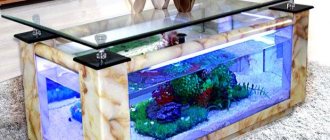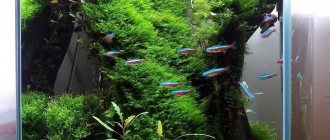Content
- 1 What is samp?
- 2 Positive aspects of using samp
- 3 How does samp work?
- 4 Sump equipment for a marine aquarium 4.1 Scrubber
- 4.2 Skimmer
- 4.3 Kalkwasser, calcium reactor, etc.
- 4.4 Biological filter
- 4.5 Auto top-up
- 4.6 Heaters
- 5.1 Refugium
What is samp?
“Sump” (from the English “Sump”) is a special container for equipment connected to the aquarium.
A large amount of equipment, for example in marine aquariums, inevitably leads to the idea of hiding this equipment from view. To do this, a samp is equipped in the aquarium cabinet or somewhere else (behind the wall, etc.). A sump can be any container, but modern sumps are usually specially made special aquariums with partitions dividing them into several compartments. There are ready-made sumps on sale with all the necessary (according to the manufacturer) equipment, but many people find it interesting and exciting to make their own sump of a unique design, thought out to the smallest detail, taking into account what is needed from it.
Positive aspects of using samp
- The samp increases the volume of water in the system, which has a positive effect on its stability and allows it to survive emergency situations that could destroy the entire system if there was no samp in it.
- Due to the intake of water from the main (“display”) aquarium, a bacterial film does not appear on the surface of the water and debris does not accumulate.
- Reduces the temperature in the system. Overheating is often a big problem, especially in marine aquariums, and the sump can reduce the water temperature by about 2 °C.
- Hides equipment: protein skimmer, heaters, various sensors - all this can be moved from the aquarium to the sump.
- Maintains a constant water level in the main aquarium. Changes in water level due to evaporation and other factors will occur in the sump.
- Reduces risk when adding various substances. Adding chemicals or osmotic water to the sump will allow them to mix well with the aquarium water before they enter the aquarium.
- Samp improves water circulation in the aquarium and creates additional flow.
- Due to open water flows, the water is saturated with oxygen.
- Allows you to create filtration systems that are not possible when using canister filters.
Diseases of Marbled Gourami
After purchasing the fish, they must be quarantined for one week. They themselves are resistant to bacterial infections, but are often carriers and can infect other fish. During this period, they are recommended daily 15-minute baths with solutions of salt, the antibiotic biomycin or oxytetracycline, a weak solution of brilliant green, methylene blue or rivanol. Between baths they are kept in a separate container with clean water.
The main pathogens are viruses, bacteria, worms, ciliates and microscopic fungi. They multiply in sick fish, and then spread to other inhabitants, causing pestilence. Diseases can be provoked by deteriorating living and feeding conditions.
The most common diseases among gouramis are:
- Lymphocystosis. Signs: open wounds, grayish nodules and flat black growths surrounded by swelling. The fish looks like it has been sprinkled with semolina.
- Pseudomonosis. Signs: dark spots turning into reddish ulcers. Often accompanied by a secondary infection with saprolegniosis.
- Aeromonosis. Infection occurs from food, most often in overpopulated domestic reservoirs among weakened individuals. Signs: raised scales, inactivity, refusal to eat, swollen abdomen with bruises.
- Ichthyophthyriosis. The causative agent is a parasitic ciliate that affects fish with weakened immune systems. Very often, the disease affects aquarium inhabitants during the demi-season period, when the temperature in the akarium can fluctuate sharply. Signs: lethargy of the fish, small white rashes all over the fish’s body.
To avoid these troubles, it is enough to provide proper care and proper feeding. But in general, these are very unpretentious, friendly, interesting and beautiful fish that even a beginner can handle. And the ability to destroy aquarium parasites makes them doubly useful.
How does samp work?
Water rises from the sump to the aquarium using a return pump. The water level in the aquarium exceeds a certain level and enters an overflow box or overflow column, from where it flows back into the sump by gravity. It turns out to be a closed cycle.
The main task when organizing water exchange with an aquarium is to ensure maximum water circulation. The share of the flow from the return of water from the sump to the aquarium is 3-5 volumes of the aquarium; the rest of the flow, if necessary, is created using flow pumps and other technological devices. When designing a system, it should be remembered that the water discharge into the sump must be able to return the required amount of water to the sump.
Purpose
An aquarium sprayer is a fairly simple device. It provides decent conditions for the existence of fish and other organisms, additionally being an excellent decoration of the underwater environment. In addition, small air bubbles themselves look great.
This equipment saturates the aquarium with oxygen.
Thanks to its use , layers of liquid move, the temperature is equalized, and the desired microclimate is formed in the container, in which its inhabitants feel calm and comfortable. With a large number of fish and other organisms, such an adaptation is simply necessary.
- Sprayer for an aquarium: varieties and making your own
The atomizer disperses air at high speed and saturates the water with oxygen (O2), suppressing carbon dioxide (CO2).
Sump equipment for a marine aquarium
scrubber
In fact, it is difficult to imagine a scrubber outside of a sump.
Skimmer
The sump allows you to conveniently position the skimmer (foam separating column), which removes organic matter. Many skimmers require a constant water level to operate, which is easily achieved by creating a special sump compartment. In addition, there are skimmers specifically designed for installation in such a compartment. The larger the skimmer, the greater its productivity; therefore, with a larger skimmer, the system will be much easier to withstand an organic outbreak.
Kalkwasser, calcium reactor, etc.
As already mentioned, equipment supporting the chemical composition can be located in the sump. Drops of saturated solutions of chemicals have time to mix well with water before entering the main aquarium.
Biological filter
In heavily fished aquariums, additional biological filtration may be required. Instead of an external canister, it is much more convenient to use a separate compartment of the sampa, filling it with bioballs or coral chips.
Auto top-up
Auto top-up is very popular. A sensor is installed in the compartment with a variable water level, which, if the water drops below a certain level, turns on a small pump that adds osmotic water or a kalkwasser from a special container.
Heaters
In cold weather, water heating may be required. There is no point in placing heaters in the main aquarium if they can be placed in a compartment with a medium flow and a constant water level.
How the device works
The principle of operation of the aquarium sump:
- From the main reservoir, the liquid moves to the first section of the device, where filtration occurs.
- After cleaning, the water mass enters the second section, which is filled with a substrate for biorefinement.
- From the second compartment, the liquid overflows over the edge of the partition, moving into the third zone, where the nitrite neutralizer is installed.
- In the fourth compartment, the liquid warms up.
- In the fifth compartment there is a pump that returns the water mass to the main reservoir.
This is a brief description of the principle of operation of the samp. Of course, there are many different variations in the structure of the device, which may differ from the work given above.
Sump compartments for marine aquariums
The compartments are separated from each other by vertical partitions. The compartment where water from the aquarium is supplied has the highest water level. The height of each subsequent partition determines the water level in the compartment it separates.
To get rid of noise due to water overflowing over the edge of the partition, the partitions are made with a slight slope so that the water flows more smoothly into the next compartment.
Refugium
Refugium is an illuminated compartment of a sump with algae. Algae absorb nitrates from the water, oxygenate the water and maintain the pH level when the lights are turned off in the main aquarium. In this compartment you need to provide a much slower flow of water than in the rest of the sump.
In addition, the refugium serves as a compartment in which microplankton lives and reproduces. Part of it ends up in the main aquarium, where it becomes an essential nutritional element for corals and other inhabitants.
Skimmer compartment
A foam separating column is installed in this compartment; its dimensions completely depend on the dimensions of the model that will be used. It should be noted that some skimmers require a certain level of water in the compartment to operate.
Bubble catcher
From the compartment where the skimmer is installed, water comes with many tiny bubbles. It is advisable to get rid of them before the water goes into the refugium. Most often, 3 partitions are installed at a distance of 2-3 cm, of which the central one is raised 2-3 cm above the bottom.
A sump design is possible in which the return compartment is located between the compartment with the skimmer and the refugium - in this case, the water enters them through separate pipes and there is no need to get rid of bubbles.
Return compartment
The return pump is installed in this compartment. Typically this compartment is also a variable water level compartment. A change in the volume of water in the system due to evaporation and other factors will occur in this compartment, since the water level in the aquarium is maintained by the height at which the overflow is made, and in other compartments of the sump the water level is maintained by the walls.
When designing this compartment, it should be remembered that it must be able to accommodate the entire volume of water that will drain from the aquarium into the sump in the event of a power outage or failure of the return pump. To prevent the siphon from draining too much water from the aquarium, several holes should be made near the end of the return pipe lowered into the aquarium, 10-15 mm below the surface of the water, so that air can enter the pipe. The entire volume of water located above these holes will merge into the sump.
Other compartments
What other compartments can there be in the sump? For example, a compartment for a biological filter with bioballs or coral chips. If you plan to use a calcium reactor, you need to provide a place for it. It may also make sense to provide space for all kinds of denitrifiers, auto-topping systems, phytoplankton incubators, filters for removing phosphates, activated carbon, ultraviolet sterilizer... An incredible number of different devices and devices are now being produced, and there is no point in listing them all. Moreover, it is very difficult to say in advance which devices will be added to the system some time after launch. Don't worry if you end up with empty or half-empty compartments - they may well come in handy in the future.
Important points
- When gluing the body of a technical “can,” you need to use only special silicone, and the thickness of the glass must be at least 5 mm.
- The width of the 1st compartment must be at least 10 cm; this is necessary for better mechanical cleaning (the area of the filter material increases).
- Installation of compartment partitions cannot be carried out without first checking the container for leaks.
- Partitions 1 and 3 should be glued together in such a way that their lower cut is 1.5–2 cm above the bottom (for the passage of water). In general, partitions should be glued sequentially: each subsequent one is installed after the seams of the previous wall have hardened.
- The drain and fill holes can be located both at the bottom and in the side walls of the main container. But in any case, a special overflow shaft must be made in the aquarium, fenced off from the rest of the aquatic environment with a comb or brush. This is necessary so that no algae or living organisms get into the overflow device (through which water flows by gravity into the sump).
Drilling glass is not an easy process. One wrong move and the entire surface will burst.
That is why you need to drill with diamond drills at low speeds, without pressure, the drill must be positioned strictly vertically. Water should be constantly added to the drilling site. Drilling holes in the cabinet lid, as a rule, does not cause any difficulties.
By the way, you can avoid the process of drilling glass: there is a known option for placing a sump filter above the main aquarium. However, this is hardly convenient in terms of maintenance and monitoring its condition.
- Electrical equipment (heater, lamps, pump) must be in waterproof cases, electrical wiring must be covered with a sealed cable duct.
After starting the sump, you should not expect an instant result of biofiltration. It will take approximately 3-4 weeks until the bacterial colonies begin to work effectively.
For many years now, sumps have been successfully performing their functions of comprehensively purifying large volumes of aquarium water. Easy to use and invisible in their normal operating position, these devices reliably take care of the health of aquarium inhabitants.
6 AQUARIUM COOLING METHODS
THE BEST CORAL REEFS IN THE WORLD
HOW TO CHOOSE AN AQUARIUM FOR YOUR HOME: DESCRIPTION, PHOTO
Sump dimensions
First of all, the size of the sump is limited by the free space where you are going to place it. It should be borne in mind that many skimmer models require a certain water level to operate properly. If the skimmer is designed for too shallow a depth, you can raise it using a suitable stand. In addition, you must remember that the sump requires some maintenance. It should be possible to reach into it with your hands, for example, to weed out algae in the refugium. It is highly desirable that the skimmer can be removed without draining the water.
Also, the sump should accommodate the water drained from the aquarium during power outages. After starting the samp, you need to check that the calculations are correct. To do this, turn off the return pump and wait. If there is too much volume left, then you can add water. If there is not enough space and the water tries to overflow, it will be better if this happens in the presence of the owners. In this case, it is better to reduce the amount of water in the system, then start the return pump again and mark the safe water level on the sump and never exceed it when topping up or changing, and also make sure that it is not exceeded after adding live rock to the system.
